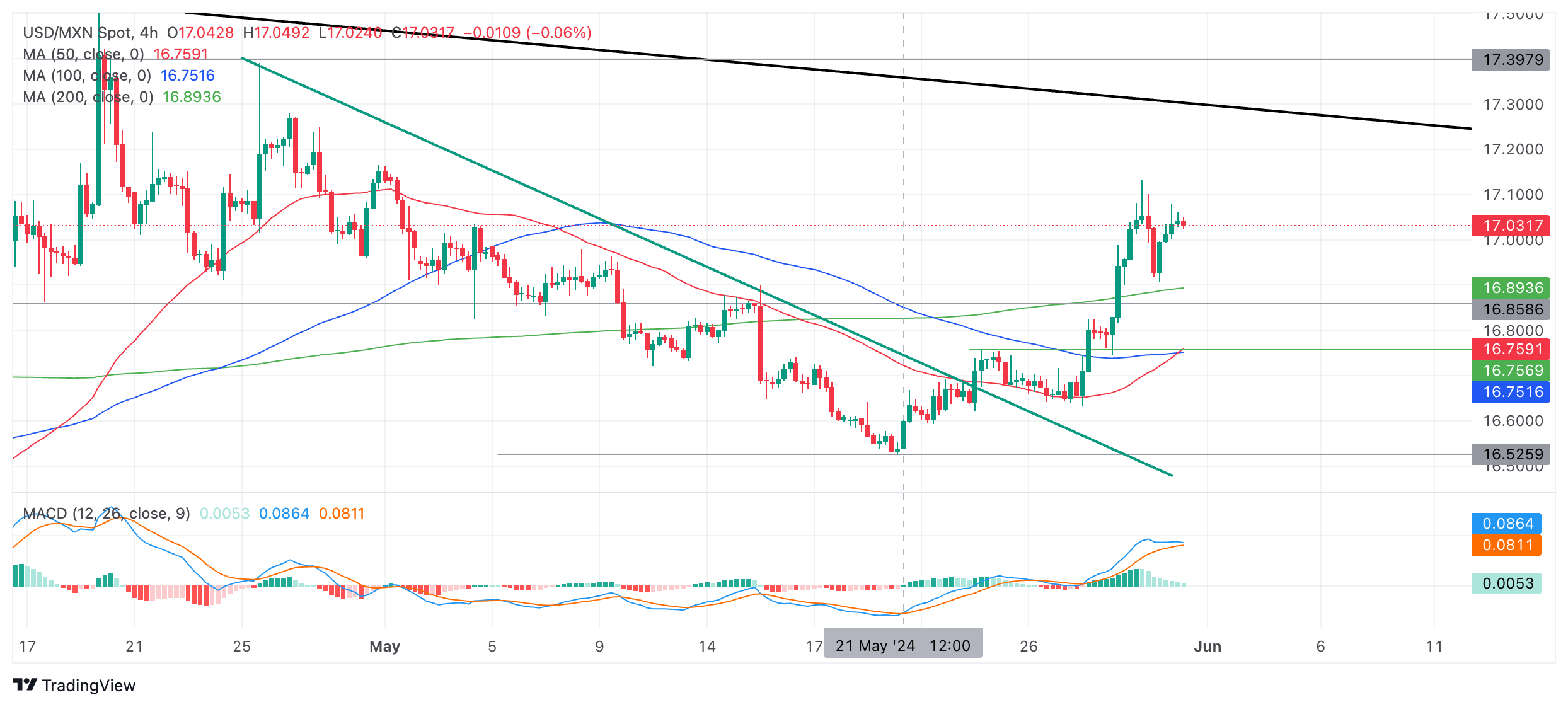Mexican Peso steadies ahead of US PCE data, presidential election
- The Mexican Peso is trading little changed on Friday as investors await key event risk on the horizon.
- Friday sees the release of US PCE inflation data, and Mexico will vote for a new President on Sunday.
- USD/MXN pulls back within a strong short-term uptrend.
The Mexican Peso (MXN) trades mixed in its most heavily traded pairs on Friday as market sentiment stabilizes ahead of key event risk. In the US, the release of Core Personal Consumption Expenditure (PCE) data for April could give clues about the future path of US interest rates and impact the US Dollar (USD). In Mexico, voters await the outcome of the next Mexican presidential elections on Sunday.
USD/MXN is exchanging hands at 17.02 at the time of writing, EUR/MXN is trading at 18.46 and GBP/MXN at 21.64.
Mexican Peso steady ahead of key event risk
The Mexican Peso seesaws between tepid losses ahead of the US PCE data for April set to be released on Friday. The data could impact interest-rate expectations in the US and, given that the difference between interest rates in Mexico and the US is a key driver of USD/MXN, the outcome could impact the Peso.
Core PCE is the Federal Reserve’s (Fed) preferred gauge of inflation so it tends to carry more heft in terms of influencing its policy direction. A higher-than-expected result could see planned interest-rate cuts further delayed, supporting the USD, whilst the opposite for a lower-than-forecast reading.
The chance of a surprise result is low, according to analysts who point out that the release is quite predictable, as it comes after the CPI and PPI releases for the same month. That said, small deviations from expectations could still generate volatility.
Interest-rate differential to narrow
The Mexican Peso’s long-term uptrend has been driven by the higher interest rates (11.0%) in Mexico compared to its major counterparts.
Although the Bank of Mexico (Banxico) lowered interest rates by 0.25% in March, stubbornly high inflation prevented it from doing the same in May. According to analysts at Rabobank, however, interest rates in Mexico are set to fall, narrowing the gap between with other countries. This, in turn, is likely to have a depreciating effect on the Mexican Peso because demand from foreign investors seeking a lucrative place to park their capital will fall.
“We maintain the view that we are at the peak of MXN strength and will see a move back above 16.8 in the coming months as the rate differential converges,” Rabobank said in a note on May 28.
Mexican presidential election
The Mexican presidential election on Sunday is likely to see Claudia Shienbaum, the candidate for the Morena party, replace Andres Manuel Lopez Obrador (AMLO) as president of Mexico. Shienbaum leads the next most popular candidate by 20% in the polls.
Her tenure is likely to see an extension of Obrador’s generous welfare programme, and she has pledged to increase the minimum wage by circa 11%. This is likely to boost consumer spending, a key driver of growth in recent quarters, but could make it difficult for Banxico to bring down inflation, says Kimberley Sperrfechter, Emerging Markets Economist at Capital Economics.
Threat of being trumped
Despite Donald Trump being convicted of 34 counts of falsifying business records, he still stands a chance of being re-elected in November. Indeed, his conviction has galvanized support for the embattled nominee from within the ranks of the Republican party and led to a flood of donations to his election campaign fund, according to AP News.
The US and Mexican trade agreement (USMCA) is up for review in 2026, and there is a risk that Trump, if re-elected, might reintroduce tariffs on Mexican goods. Such a move would also hamper Mexico’s near-shoring prospects.
For this reason, Sperrfechter thinks that the Peso’s “period of outperformance has largely run its course” and expects the currency to substantially weaken to $19-$20 during the next (Mexican) president’s tenure.
Technical Analysis: USD/MXN pulls back within uptrend
USD/MXN – or the number of Pesos that can be bought with one US Dollar – pulls back and then recovers in a short-term uptrend. Given that “the trend is your friend”, the odds favor a continuation higher.
USD/MXN 4-hour Chart

USD/MXN now sets its sights on the major trendline (black) at circa 17.25. A break above the May 30 high at 17.13 would probably confirm an extension towards the trendline target.
The medium and long-term trends remain bearish, however, raising the risk that the pair could reverse lower. As yet, there are no signs of weakness from price action, however. A decisive break above the major trendline would solidify the bullish case and indicate a bullish reversal of the medium-term.
A decisive break would be one accompanied by a long green bar that closed near its high or three consecutive green bars in a row.
Economic Indicator
Personal Consumption Expenditures - Price Index (YoY)
The Personal Consumption Expenditures (PCE), released by the US Bureau of Economic Analysis on a monthly basis, measures the changes in the prices of goods and services purchased by consumers in the United States (US). The YoY reading compares prices in the reference month to a year earlier. Price changes may cause consumers to switch from buying one good to another and the PCE Deflator can account for such substitutions. This makes it the preferred measure of inflation for the Federal Reserve. Generally, a high reading is bullish for the US Dollar (USD), while a low reading is bearish.
Read more.Next release: Fri May 31, 2024 12:30
Frequency: Monthly
Consensus: 2.7%
Previous: 2.7%
Source: US Bureau of Economic Analysis

